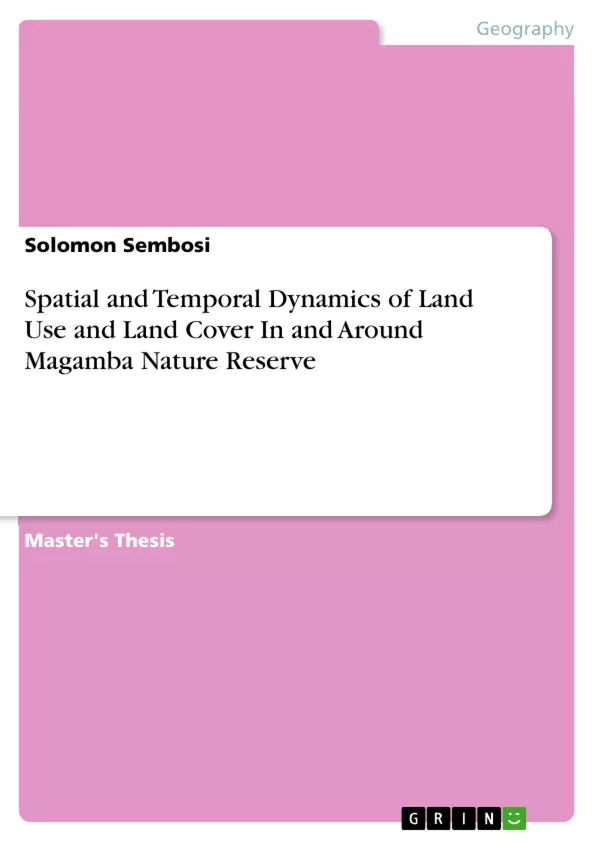This study assesses land use and land cover changes and the causes of such changes in and around Magamba Nature Reserve. Remote sensing and GIS techniques were used to quantify and analyze the trend in land use and land cover changes over the past 20 years whereby satellite images of 1995, 2008 and 2015 were used. Moreover, household surveys, direct field observations and focus group discussions were employed to obtain socioeconomic factors that influence changes in land use and land cover.
Population Census data of 2002 and 2012 were utilized to identify population density for the villages surrounding the reserve. The results indicated a major expansion of agriculture from 169.33 ha in 1995, 282.16 ha in 2008 to 902.54 ha in 2015. There was an increase of built-up areas from 36.50 ha in 1995, 911.56 ha in 2008 to 1792.92 ha in 2015 at the expense of other land covers. The identified influences for such changes include population pressure, unemployment, landless, agricultural expansion, fire and need for energy sources (e.g. firewood and charcoal). Recent increase in population and anthropogenic activities is a threat to conservation and thus should be discouraged in order to restore the degraded areas and for the sustainability of the biodiversity in and around Magamba Nature Reserve.
Magamba Nature Reserve in Lushoto District Tanzania has experienced and continues to experience major land use changes and land cover loss in natural vegetation. This has resulted in biodiversity loss, local climate change, soil erosion and forest degradation. Therefore, understanding of changes occurring in such ecosystem is of vital importance for establishing management activities.
It has been lately indicated that these problems are mainly due to anthropogenic activities as this district is among the rural areas with high population growth compared to other rural districts in Tanzania. However, these insights are little proved quantitatively.
Inhaltsverzeichnis (Table of Contents)
- Chapter 1: Introduction
- 1.1 Background
- 1.2 Problem statement
- 1.3 Objectives
- 1.3.1 General objective
- 1.3.2 Specific objectives
- 1.4 Justification of the study
- 1.5 Scope of the study
- 1.6 Organization of the study
- Chapter 2: Literature review
- Chapter 3: Materials and methods
- 3.1 Study area
- 3.2 Data collection and analysis
- 3.2.1 Remote Sensing and GIS data
- 3.2.1.1 Satellite image acquisition and processing
- 3.2.1.2 Image classification
- 3.2.2 Field data collection
- 3.2.3 Data analysis
- Chapter 4: Results and discussion
- 4.1 Land use and land cover changes
- 4.2 Socioeconomic factors influencing land use and land cover changes
Zielsetzung und Themenschwerpunkte (Objectives and Key Themes)
This dissertation investigates the spatial and temporal dynamics of land use and land cover changes in and around Magamba Nature Reserve, Lushoto District, Tanzania. The study aims to quantify these changes over a 20-year period and identify the socioeconomic factors driving them. The objective is to provide insights into the impacts of these changes on biodiversity and suggest management strategies for the sustainable management of the reserve.
- Land use and land cover changes in Magamba Nature Reserve
- Socioeconomic drivers of land use and land cover changes
- Impacts of land use and land cover changes on biodiversity
- Management strategies for sustainable conservation
- Remote sensing and GIS techniques for land use and land cover analysis
Zusammenfassung der Kapitel (Chapter Summaries)
Chapter 1 introduces the study's background, problem statement, objectives, justification, scope, and organization. Chapter 2 provides a comprehensive literature review on land use and land cover changes, their impacts, and driving factors. Chapter 3 details the study area, data collection and analysis methods, including remote sensing and GIS techniques, field surveys, and data analysis approaches. Chapter 4 presents the results of the study, highlighting the quantified changes in land use and land cover over time, as well as the socioeconomic factors influencing these changes. This chapter also discusses the implications of these changes for biodiversity conservation.
Schlüsselwörter (Keywords)
The key terms and concepts explored in this dissertation include land use and land cover change, remote sensing, GIS, socioeconomic factors, population pressure, agricultural expansion, biodiversity conservation, Magamba Nature Reserve, Lushoto District, Tanzania.
- Quote paper
- Solomon Sembosi (Author), 2017, Spatial and Temporal Dynamics of Land Use and Land Cover In and Around Magamba Nature Reserve, Munich, GRIN Verlag, https://www.grin.com/document/379059



